By Eugene Liscio, P. Eng.
A detailed summary of technical features and applications for forensics (and beyond). Covered: handheld scanners from FARO, Mantis Vision, DotProduct, and Artec.
For years now, I’ve been all about using different tools for crime scene documentation and have been very interested in the 3D handheld scanning market. Mantis Vision was one of the first companies on the market with a powerful 3D scanner that could rapidly document crime and accident evidence, but initially, it was rather high priced and did not get the type of mass adoption that was hoped for.
Ironically, it wasn’t until the low cost Microsoft Kinect and Asus Xtion sensors were transformed from gaming gesture sensors to 3D scanners that a lot more interest and adoption of these technologies was garnered. Since then, much work has been done on the software side to improve the quality of the scan data and, even more importantly, the user experience. This was accomplished with simple with real-time capture software that could process and clean up the scans in a very short amount of time.
Most recently, FARO has announced the availability of their Freestyle scanner and if you are interested in a quick intro video from me, have a look below.
The FARO unit has a sensor developed in-house and software that improves on the typical structured light devices by using a stereo pair of infrared cameras to accurately triangulate the structured light pattern.
Today, with a few options available on the market that can all be applied to forensics, this is my own summary of technical features and applications of the top four most commonly available handheld scanners.
Mantis Vision, F5 and Short Range Scanner
The Mantis Vision is a very rugged and high quality scanner that uses an infrared structured light pattern. It is also one of the most expensive, but boasts some of the best quality scan data I have seen. The capture time is very fast and the ruggedized unit is made for military-grade applications. The specification sheet for the F5 states a 3D distance accuracy of 0.5mm @100cm, which is excellent for most crime scene documentation activities. For higher accuracy applications such as footprints or other small evidence, there is a short-range version that has a stated 3D point accuracy of 0.05mm.
Features missing from the Mantis scanners are real-time capture and color. Real-time capture allows the user to quickly determine what the final captured data set looks like. Although the F5 scanner comes coupled with a small handheld computer for “video” previews, it does not translate directly into a point cloud data set. So, extra care is required to ensure all areas have been captured properly. Color is not incorporated into the Mantis F5 scanner so stains, powders or other important features which may not necessarily show up as geometry can be faint or completely missed. However, the F5 is one of the only handheld scanners that can work outdoors (albeit with a bit of reduced range) in sunlight. This is a common weakness of most other handheld systems.
Applications for the Mantis products vary from general crime scene documentation, vehicle crush documentation, bullet trajectories, bloodstains and other areas where it may be dangerous and time is a factor. A quick search on YouTube will get you some application and user videos.
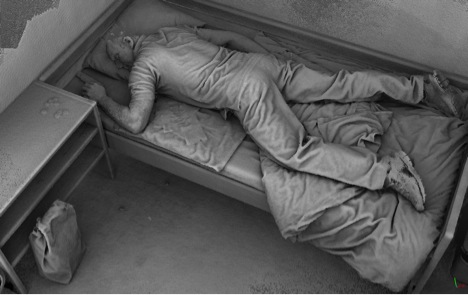
Mock crime scene with Mantis F5 data.
Artec, EVA and Spider Scanners
Artec has long been an innovative company, using structured white light technology to produce some of the best deliverables on the market. The accuracy of the Eva scanner is stated as 0.1mm, while the shorter range Spider scanner has a stated accuracy of 0.03mm. The Artec Studio software is one of the most powerful meshing and texturing tools available on the market and will allow the user to create highly optimized meshed 3D models of objects with excellent texture quality.
However, most of the Artec scanners have a small field of view and reduced range. For example, the Eva scanner seems to be one of the most popular tools for scanning human bodies or busts. Larger areas such as living rooms or garages are much more time consuming and tedious to capture since these mobile systems have difficulty tracking objects that don’t have unique texture or geometry. At a crime scene, one would limit scanning to a body on the ground, part of a vehicle (roughly 2m in size) or the location of a bullet hole in a door. Anything larger and the scanning and processing time increases significantly.
The Spider scanner makes scanning smaller objects like skulls or footprints highly practical. The quality of the geometry and texture is excellent and the capture time is very quick. Although it is possible to scan outdoors with the Artec scanners, its primary use is more often than not indoors. There are few scanners on the market that meet this level of accuracy, detail and quality for small objects.
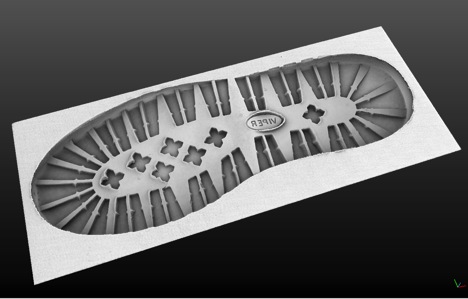
Footprint documented with Artec Spider Scanner
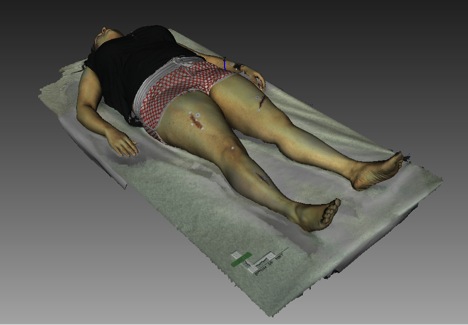
Body Documented with Artec Eva Scanner
DotProduct
The DotProduct scanner DPI-7 uses a Microsoft Kinect or Asus Xtion sensor with Primesense technology adapted to an Android tablet. This is an infrared structured light pattern that can be used to sense depth and was originally intended for gaming purposes. One of the major limitations of this type of sensor is that the accuracy is relatively low over large areas, being in the range of several millimeters. However, for many mapping applications, the speed and ease of use of this system are great advantages. The sensor has a wide field of view (approximately 60° horizontally), so more can be captured in a single sweep of the scanner. This means that areas in the range of 5m or so can be captured to get general measurements and positions of objects to create plan drawings. It also saves the technician from measuring things by hand, which could be extremely difficult in many cases without the use of a non-contact device.
As many familiar with the technology may know, the Kinect and Xtion sensors are not intended for outdoor use or in very sunny places since the sun interferes with the infrared pattern of the sensor. But dark situations are not such a challenge with the PointGun scanner, since it comes equipped with a large diffuse light that allows for scanning in low light.
What is most impressive about DotProduct’s scanner is their Phi.3D software and how far they have been able to push this low cost sensor. The tablet software is easy to use, provides real-time feedback, and includes target tracking as an option for quick capture of smaller scenes. While the overall accuracy may not be as high as some might desire, it is sufficient to provide general crime scene layouts and create plan drawings for the locations of evidence. The color visualization and ability to export data to many file formats including native support for in CloudCompare are great features. The DotProduct system provides some of the best quality Kinect based data I have seen.
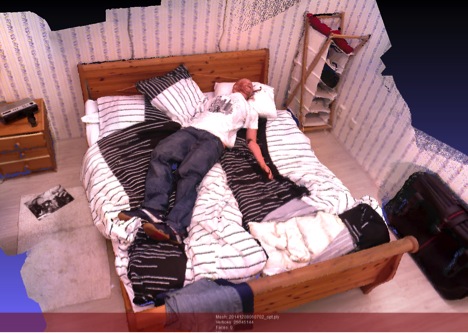
Mock crime scene from the CSI experience lab of the Netherlands Forensic Institute.
FARO Freestyle
FARO recently released their Freestyle hand held scanner, which is a step up in structured light technology since it uses not one, but two infrared cameras to create a “stereo pair” of images looking at the structured light pattern. This is analogous with how humans see (with both eyes) and provides for increased accuracy. The stated point accuracy of the system is roughly 1.5mm, with a scanning range of 3m (although in my own tests, I have shown to capture data off of bright walls at greater distances).
The Freestyle scanner takes many features from other systems and integrates them in the overall system. For example, the sensor itself is a high quality and robustly made design using carbon fibre construction. This minimizes the movement of the optics so that calibration is maintained over a wide range of temperatures. A calibration plate is supplied with the unit so validation and calibration in the field are easily accomplished in seconds. Also, the system uses a standard Windows Surface 3 tablet with USB port and the FARO Scene Capture software, which has the sole purpose of making the documentation process simple and easy to perform. Users get real-time feedback on how well the system is tracking and scanning, as the display uses a split screen configuration that shows the developing point cloud data. Color is captured and integrated into the system, as is a white balance feature for creating more realistic colors while in non-natural lighting conditions.
One of the main goals of the Freestyle was to easily integrate with FARO Focus data since the idea is to use the handheld scanner in hard to reach places, while the terrestrial scanner documents the larger expanses. The two data sets can be integrated through “Scene Process” software or the soon to be released version of FARO Scene 5.4 which will include an interface for importing Freestyle data.
The Freestyle is intended for indoor use, although I have captured data very good data on overcast days. Darker environments are possible with the help of an onboard USB flash device. However, battery usage is a concern, since the Freestyle sensor and flash are powered by the tablet. Therefore, the tablet should be fully charged if you are planning any intense use.
Dark objects need additional “hover” time to get more points but on the contrary light colored objects scan very quickly and with a lot of density. It will be interesting to see how the Freestyle progresses in the coming months.
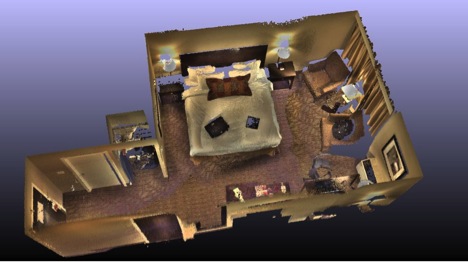
Hotel room scanned with FARO Freestyle
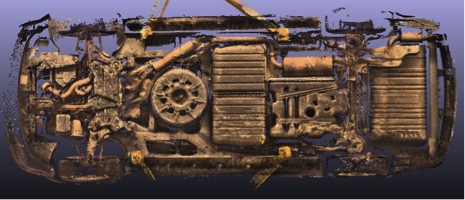
Vehicle undercarriage with FARO Freestyle
Conclusion
As 2015 progresses, it is hoped that new products, sensors and scanning systems enter the market to bridge the gap between close-range scanning and mid- to long-range terrestrial scanners. Handheld scanners have a definite role in forensics, especially when greater capture speed, higher accuracy and overall quality of the data are improved over traditional methods of documentation. Cost is certainly a factor, but of more importance is the ease of use and integration to other packages and workflows. Some recent news about “professional” scanning technologies being implemented into consumer tablets and cell phones could mean that in the future, the smartphone will become another tool in the scanning toolbox. For the moment though, it would be nice to see the evolution of professional tools for professionals first, before we give the handheld scanning market away to the average consumer to make bobble heads.





